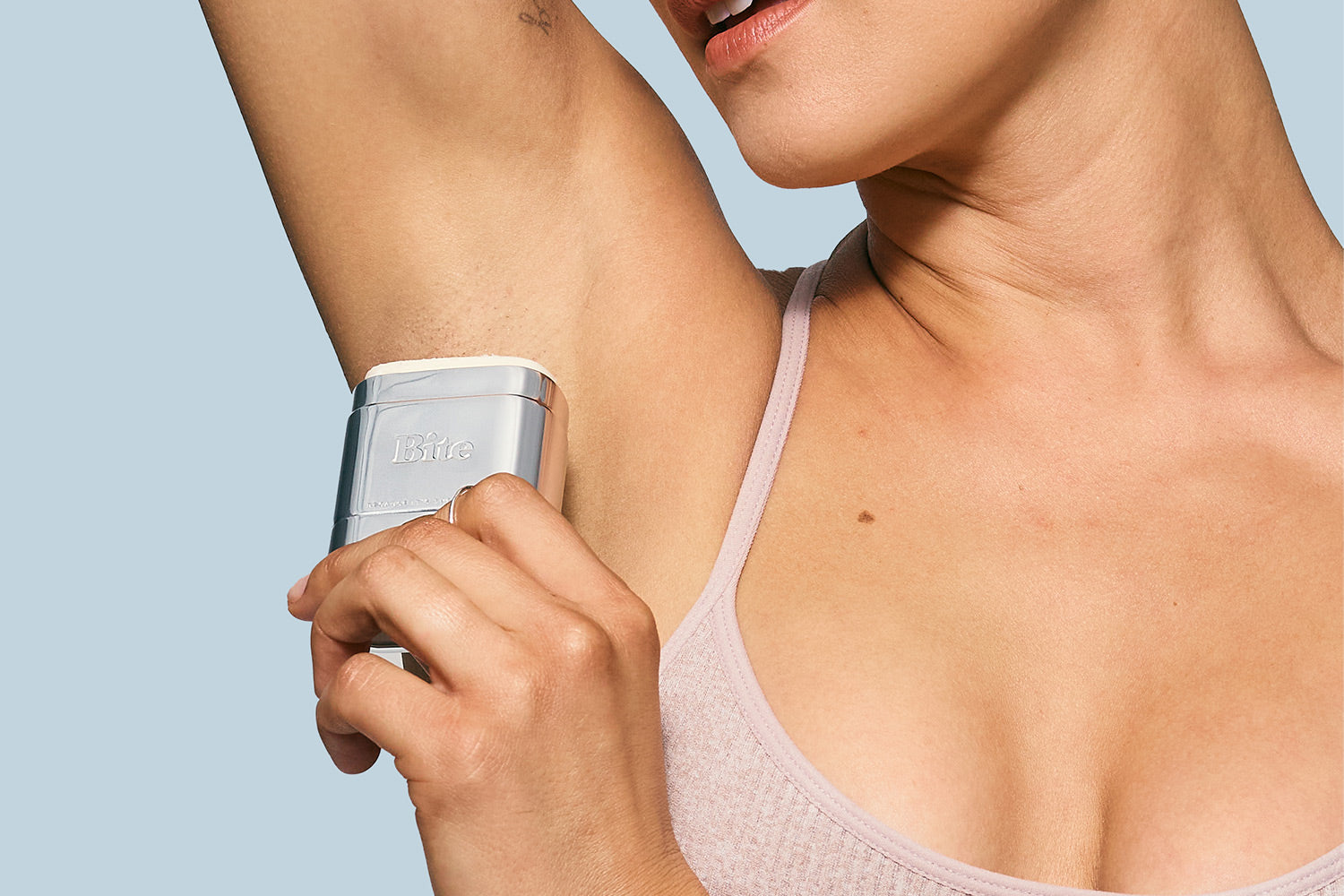Sustainable Deodorant
The vast majority of us regularly wear deodorant, and the rest of us likely regularly thank them as a result. It is simply one of the many personal care items that most of us can’t or at least do not want to live without.
The many benefits of deodorant are not up for debate. After all, it makes us smell better and feel more confident. What is there not to like? Well, there’s the plastic waste to consider.
Can Deodorant Be Sustainable?
A deodorant can absolutely be sustainable. It is just hard to imagine when you think of the plastic-lined deodorant aisle at a local drug store, but some brands like Bite are actively working to create sustainable and effective options for our everyday personal care products.
It’s not just about the plastic waste, although that is a problem of massive weight - 15 million pounds of deodorant packaging is created and ends up in our trash every year. How deodorant is made and the ingredients used also contribute to the product’s sustainability. Keep reading if you are not exactly sure what this means or how to traverse the wide world of sustainable deodorants.
What Makes a Deodorant Sustainable?
Before asking what makes deodorant sustainable, it is possibly an even more worthwhile question to ask what makes it unsustainable. In short, the abundance of plastic is so common in most deodorants on the market, from the makeup of the product itself to the applicators they are housed in.
Ingredients
Another element that renders a deodorant not sustainable is the ingredients it contains. Other than potentially containing microplastic or plastic microbeads, there are all too many other artificial ingredients that can quickly turn a product into one that harms the environment.
In order for it to be good for you and the planet, the product should be free of parabens and instead contain natural ingredients making up its antiperspirant such as shea butter, cocoa butter, clays, arrowroot powder, coconut oil, and more. These should be totally aluminum-free deodorants, as well.
If you are at all concerned about the potential smell-wicking properties or the product’s ability to fight any and all odors your armpits could produce, no need to worry. Where other traditional deodorants may forego organic ingredients, essential oils are incredibly effective at combating odor-causing bacteria. Just some of these potential essential oils include:
- Citrus Scents (lemon, orange, etc.)
- Eucalyptus
- Lavender
- Rosemary
- Peppermint
Baking soda is often used in eco-friendly deodorants, but it can be harsh on sensitive skin. Instead, look for a zero-waste deodorant containing ingredients such as coconut oil and organic shea butter.
Shipping Methods
Yet another factor that can result in a less than sustainable deodorant is the packaging and shipping methods. Many companies use significantly more packaging for their product than is actually needed. Though this may have some aesthetic merit by making a company’s items stand out more on a store shelf, it is a very short-sighted endeavor.
When it comes to shipping, consider whether an organization overnight ships their products or uses existing postal routes. It’s also important to understand if the product is direct-to-consumer or being shipped through retail, as well as consider where their products are made which will determine how far they have to travel to be shipped to you.
All of these contribute to the burning of fossil fuels and energy that are dangerous for the environment and add to our already immense carbon footprint.
Plastic-Free Deodorant
Instead, look for a deodorant that does not contain unnecessary plastic. Or, better yet, look for a totally plastic-free, environmentally friendly deodorant. These often come in the form of natural deodorant made without chemicals in paper tubes or a recyclable deodorant case.
Recently, refillable deodorant has been becoming more popular. This means that once you are done with your initial stick deodorant, a new stick can be inserted for further use.
As discussed, it is definitely best to look into plastic-free and zero-waste deodorant whenever possible. Between 4.8 and 12.7 metric tons of plastic go into our oceans every year, where it is left to harm marine life and create dangerous emissions that worsen the effects of climate change.
Much of the plastic that ends up polluting the ocean is single-use plastic, and it often comes from personal care products such as traditional toothpaste tubes and deodorant. We have the power to fight back against this by using plastic-free solutions whenever possible.
Compostable Refills
Less packaging, the better. Better yet, the existing packaging should be recyclable. Even better, it should be compostable.
Composting is the process of decomposing organic materials, eventually resulting in a nutrient-rich substance that works wonders as a fertilizer. Compostable packaging means that you can stick it into a backyard compost bin or a community compost pile after it is used. If compostable materials do make their way into a landfill, they will still decompose over time.
The materials used to make the packaging came from the earth, and they can now be returned to the earth, completing their natural cycle.
Vegan and Cruelty-Free Ingredients
While your deodorant is sustainable, it must also be ethical in more ways than just that. When shopping around for products, look for vegan and cruelty-free friendly.
Are Clean Deodorants Sustainable?
This is a multifaceted issue because clean deodorants are certainly more likely to be sustainable, but that is not always the case. Having clean ingredients shows that the company cares about its products, but that does not necessarily mean its packaging is sustainable.
This also depends on your precise definition of both “clean” and “sustainable,” as both can have slightly different meanings to different people. Just be sure to do your research, read reviews, and find a brand and product that aligns with your values.
What Ingredients Should We Look For In a Sustainable Deodorant?
When it comes to a sustainable deodorant, you will want to look for ingredients that come from the earth and can one day be returned to the earth. These ingredients should be clean and come from nature.
Shea Butter
Shea butter is a natural ingredient that seems like it was made for deodorant. It locks in moisture while locking out odors and sweat. Shea butter is used far and wide for various purposes related to beauty and skincare. In the case of deodorant, though, it leaves your pits pristine.
Zinc Ricinoleate
With deodorant, we all want something that will keep the will of our sweat glands at bay and instead leave us feeling refreshed. This is exactly where zinc ricinoleate comes in super handy. This ingredient is a powerhouse in the odor-absorbing department, making it perfect for any natural deodorant.
Tapioca Starch
Tapioca starch accomplishes a few different goals when used in deodorant recipes. For one, it acts as a thickener that helps bulk up your deodorant and keep it together.
Next, it also works wonders when absorbing odors. It acts as a great baking soda replacement, making it a very popular option. By the way, it also does all this while being gluten-free.
Safe Fragrances
Lastly, you will want your deodorant to contain a safe, clean fragrance that will leave those with and without sensitive skin ready for a long night of raising their hand. As mentioned, these can come in the form of essential oils.
When it comes to Bite’s zero-waste, sustainable deodorant, we have three different delightful scents to choose from. Whether you go with Neroli, Rose Vert, or Santal, you now have an all-natural, beautifully smelling deodorant that has your back even in the sweatiest of situations.
What Is the Most Sustainable Deodorant?
It would be easy to be biassed and say the most sustainable deodorant is our refillable, clean, and recyclable deodorant, and it is absolutely one of the best out there. To give one single deodorant the title of “most sustainable” is impossible. Again, this depends on your specific interpretation of sustainability, so all you can do is be thorough in your investigations.
Conclusion
The first step to sustainable living is awareness, and by reading this article, you are now significantly more aware of what to look for in your deodorant options. So let us be the very first to say: congratulations, and happy sweating!
Sources:
How Much Plastic Is in the Ocean? | Natural History Museum
The Composting Process | University of Illinois
Shea Butter Benefits: Face, Hair, Skin, Scars, and More | Medical News Today


